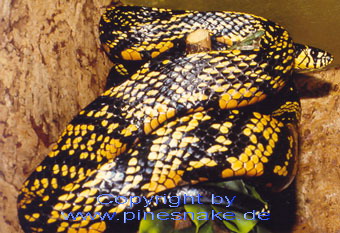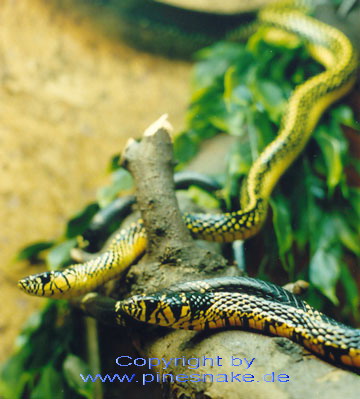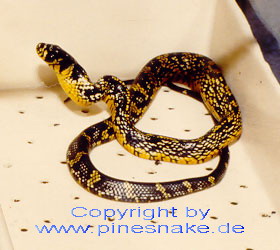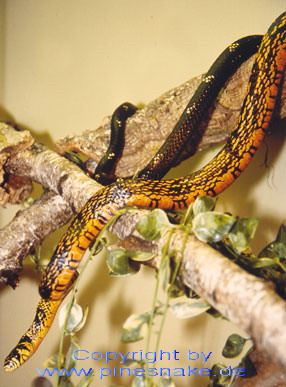|
I got 1.2 Spilotes for this in November 97. Male, about 2.2 m, WC, yellow, bought at a reptile-fair and 0.2 NZ 95, orange, the about 1.4 m long.
I put the animals together after each other some days later. The two males executed at times easy pursuing code of conduct fights and sliping over the other animal, but I could safely let the animals together. One of the new females was held one by one. It refused the food many months and began eating itself in April 98. All other animals ate regularly.
I then gave one of the 0.1 CB 95 to the same friend who also got the CB 89 male in April 98. CB were never obtained however there.
In this year the yellow and the orangene female both laid no eggs. The yellow female ate fewer in the winter again.
In the beginning of 99 I put my Spilotes again together and mating tests could be seen.
On 2-19-99 the orangene female laid unexpectedly 6 eggs of which only 3 however were fertil. Well, the mating probably have been in fall. The eggs were transported into the incubator as above-mentioned. The females were put one by one again on this and carefully resumed food.
The yellow female then on 4-3-99 died because of exhaustion (?). It had at the time of death a length of 2.1 m.
The three animals of the stimulated eggs then on 5-7-99 started with the slip. The first shed of the skin had 70-77 cm of length.
In the middle of June 99 I passed the three on to a friend in Bremen/Germany. Some years later my friend sold them further and we never heard anything about the snakes again.
My orange male, the WC 89 died in 14.05.99 with a lengh of 2,2 m.
After the winter 2000 became the remained animals put together again but mating activities weren't watched.
The orangene female put an unfertilized egg on 24-05-00, 5 eggs were put down on 5-29 once again. 2 of this were fertil, 3 unfertilized. The two fertil eggs were transported again into the incubator under above-mentioned conditions. The two animals then started with the slip on 13-08-00.
The animals, it were 0.2, after the first shed of skin began to eat thawed nest young mice and were sold to in the middle of September to England. The orange female then died without obvious reason in the middle of August 2000. The yellow male stoped the feeding in winter, he starts a little eating in May 2001 again. He also died in winter 2002/2003.
|





